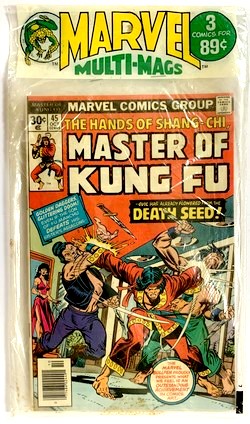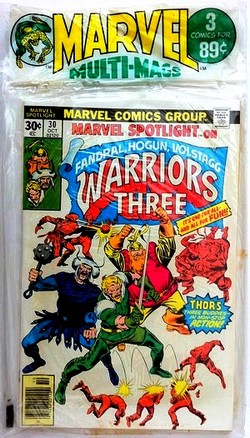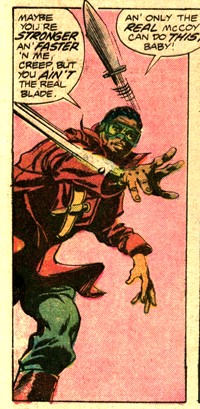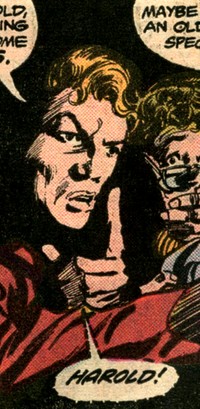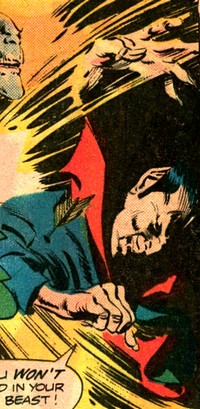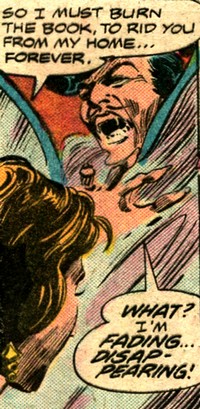 |
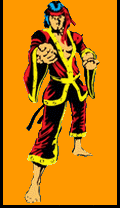 |
|
SHANG-CHI,
DRACULA &
THE WARRIORS THREE
BACK
TO BACK IN A
OCTOBER
1976 MARVEL MULTI-MAGS
|
|
|
|
| |
|
| |
|
| |
|
| |
MARVEL
MULTI-MAGS |
|
Even in the early
1960s, the comic book industry
realized that in spite of the
hugely successful comeback of the
superhero genre (which had been
clinically dead for most of the
1950s) and the subsequent streak
of new creativity and enthusiasm
it generated, its traditional
sales points were fading away.
Small stores that had carried
comic books were pushed out of
business by larger stores and
supermarkets, and newsagents
started to view the low
cover prices and therefore tiny
profit margins comics had to
offer as a
nuisance. Many ideas on how
to turn these developments around
were put forward by different
publishers, but the most
successful concepts strived to
open up new sales opportunities
and markets and thus tap into a
new customer base.
|
|
|
|
| |
| One place these potential
buyers could be found was the growing number of
supermarkets and chain stores. But in order to be able to
sell comic books at supermarkets, the product would have
to be adjusted. |
| |
| Handling
individual issues clearly was no option for these
outlets, but by looking at their logistics and
display characteristics, DC Comics (who came up
with the Comicpac concept in 1961) found
that the answer to breaking into this promising
new market was to simply package several comic
books together in a transparent plastic bag. This
resulted in a higher price per unit on sale,
which made the whole business of stocking them
much more worthwhile for the seller. The simple
packaging was also rather nifty because it
clearly showed the items were new and untouched,
while at the same time blending in with most
other goods sold at supermarkets which were also
conveniently packaged. |
|
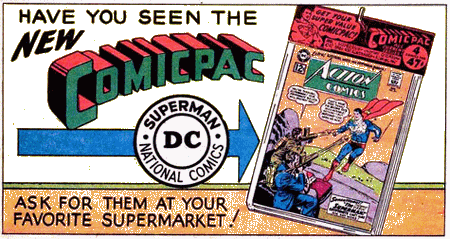 |
|
| |
| Outlets were even supplied with dedicated Comicpac
racks, which enhanced the product appeal even more since
the bags containing the comic books could be displayed
on rack hooks in an orderly and neat fashion. |
| |
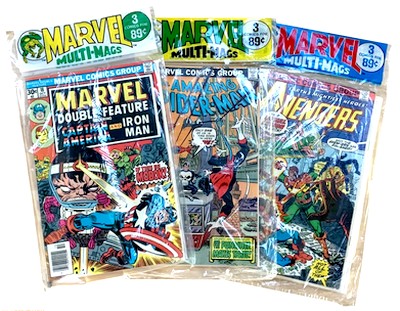
|
|
DC's
"comicpacks" were a success -
so much so that other publishers quickly
started to copy it. Marvel produced a
series of Marvel Multi-Mags in
1968/69 but then seems to have dropped
the idea again. However, by the
mid-1970s, the House of Ideas had
once again fully embraced the marketing
concept of selling multiple comic books
packaged in a sealed plastic bag to a
customer base which comic books could
hardly reach otherwise: people shopping
at supermarkets and large grocery stores.
It didn't really matter therefore that
buying these three comic books in a
comicpack for say 89˘ (rather than from
a newsagent for 90˘
in that case)
clearly presented no real bargain - it
was the opportunity and convenience to
pick up a few comics at the same time
parents and adults did their general
shopping. Neatly packaged, it almost
became an entirely different class of
commodity.
|
|
|
| |
|
| |
| The MARVEL MULTI-MAGS we are
looking at here features three titles: Master of Kung
Fu #45, Tomb Of Dracula #49, and Marvel
Spotlight #30, all from the October 1976 cover date
run. This meant that they were actually on sale at
newsagents in July 1976, although there could be quite a
delay in terms of actual availability of MARVEL
MULTI-MAGS at some sales points, resulting in
Multi-Mags on display that contained "semi-recent
books (typically about nine months old)"
(Brevoort, 2007). Considering the packaging and
distribution process, this doesn't really seem too
surprising. This specific
three-pack is somewhat special in that it belongs
to a small number of late 1976 and early 1977 MARVEL MULTI-MAGS that came
with a yellow and green on white (3
comics for 89˘) label, which display the anomaly of
not having a seal-line below the label. Heat
sealing the bag at this point served two purposes.
Firstly, it provided a somewhat strengthened label (which
of course also doubled as a hanger for most displays), but secondly - and just as importantly
- it also provided a tighter fit for the comic books, by
restricting their vertical movement inside the bag.
The lack of the sealing line below the label is in
fact a major defect with regard to how well the packaging
protects its contents, since the comic books inside a MULTI-MAGS polybag of this type are not restricted
from moving about into the label part of the sealed bag -
quite unlike those packaged inside a "regular" MULTI-MAGS polybag (i.e. with a sealed off label).
In some cases - as the example here shows - this
protective partition was achieved (to a degree) by the
use of staples.
|
| |
|
| |
| These could have been applied
by some resellers upon delivery (or even years later by
third parties); it is doubtful that this took place at
the original packaging facility. |
| |
| In any case, the staples did what they were intended
to do and prevented any excessive physical damage to the
three comic books inside the polybag - especially
noticeable when compared
to issues that were allowed to "move
freely" in such a MULTI-MAGS. No titles had permanent slots in
the MARVEL
MULTI-MAGS, but the
three titles packaged into this example were hardly ever
packaged into Marvel's threepacks. To date, out of the
210 known examples of MARVEL MULTI-MAGS, Master of Kung Fu only
featured in three of them, the same number of times as Tomb
Of Dracula, while this issue of Marvel Spotlight
is the one and only documented occasion that this
title was included. The way
in which individual issues were selected for inclusion in
MARVEL MULTI-MAGS is not at all clear and does,
at times, seem slightly haphazard; the MARVEL MULTI-MAGS in question here certainly
contains nothing but rarities.
But even with titles
that turned up frequently - such as Hulk, Thor
or Amazing Spider-Man - there was no guarantee
of an uninterrupted flow of consecutive issues - and
therefore a distinct possibility of missing out on a part
of the storyline. On top of this, the continuity of the
Marvel Universe of the 1970s was such that plots and
storylines usually evolved over more than one issue.
This didn't exactly
make the MULTI-MAGS an ideal way of getting your
Marvel comic book fix. However,
one needs to bear in mind that this was a common fate of
the average comic book reader in the 1970s Bronze Age,
whether his or her comic books came packaged in a plastic
bag or as single issues from a display or spinner rack.
Back in those days, an uninterrupted supply of specific
titles simply was not guaranteed. Not worrying too much
about possible gaps in storylines became something of a
routine - besides, you would usually get a recap of
"what happened so far" on the first page.
So all in all it simply was a
part of being a comic book fan in the 1970s - as were the
monthly Bullpen Bulletins (which were the responsibility
of the editor-in-chief) and the in-house advertising
(often with mouth watering cover reproductions).
|
| |
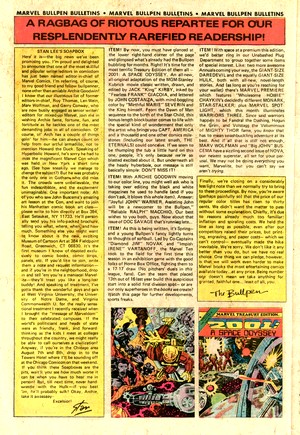 |
|
| In October 1976, the
Bullpen Bulletin was still on its way
through the alphabet as far as its title
was concerned, arriving at the letter R -
which resulted in the typically
alliterative and somewhat nonsensical
title "A Ragbag of Riotious
Repartee for Our Resplendently Rarified
Readership!". The big news -
and the headline item of Stan Lee's Soapbox
column - was the promotion of Archie
Goodwin to Editor-in-Chief.
Lee also mentioned the "illustrious
list of former editors-in-chief, Roy
Thomas, Len Wein, Marv Wolfman, and Gerry
Conway" but diligently avoided
pointing out that this position had fast
become a revolving door affair, with
those four gents successively at the helm
between 1972 and 1976, all of them
stepping down to be able to spend more
time writing (with Conway only lasting
six weeks as EIC).
|
|
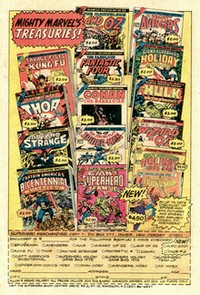 |
Also not mentioned by Stan Lee
on this occasion was the fact that Archie Goodwin
only agreed to fill the position on the
assumption that it would be temporary, until a
permanent replacement could be found; ultimately
Goodwin would resign at the end of 1977 (Howe,
2012).
|
|
| |
| As for the actual Bullpen Bulletins' various ITEM!
bullet points, they were - as usual - mostly concerned
with new and changing assignments to various writers and
artists, as well as Marvel's ever expanding line of
titles - in this case the major push was given to the
Super Treasury Edition of Kirby's 2001: A Space
Odyssey, an adaptation of the movie. It would be
followed in December 1976 by an ongoing series of the
same title which, however, would find few favours with
readers and be cancelled after a mere ten issues. The
final item of news was both bad and not really news at
all - Marvel's need (for reasons explained in this
Bullpen Bulletin in a separate box) to raise the cover
price for their regular comics from 25˘ to 30˘.
Following a few tests in select markets to gauge buyer
reactions to the 5˘ hike, the higher price was
introduced as of September 1976 (cover date), i.e. the
previous month. The price for a MARVEL
MULTI-MAGS rose accordingly, to 89˘ for three
comics instead of the previous 74˘.
|
| |
|
| |
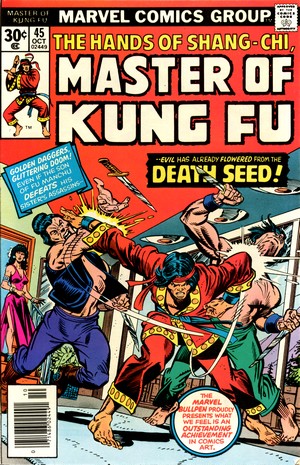
|
|
MASTER
OF KUNG FU #45
October 1976
(monthly)
On Sale:
13 July 1976
Editor
- Archie Goodwin
Cover - Gil Kane (pencils) & Al
Milgrom (inks)
"Death Seed!"
(17 pages)
Story - Doug
Moench
Pencils - Paul Gulacy
Inks - Pablo Marcos
Lettering -
John Costanza
Colouring - Petra Goldberg
STORY
OVERVIEW
- Shang-Chi
and MI6 agent Clive Reston are in
Switzerland to confront Fah Lo Suee, Fu
Manchu's evil daughter and her two
henchmen, the Golden Daggers. They learn
that Dr Petrie is the mole in their midst
and that one of Fah Lo Suee's assets is
actually a Swiss agent. Subsequently,
Shang-Chi, Reston and Leiko (Shang-Chi's
love interest) fight their way out of a
tight spot, while elsewhere Fu Manchu is
advancing plans for his return...
|
|
|
| |
| Master of Kung Fu was one of Marvel's many
titles of the 1970s which moved somewhat outside of the
traditional superhero theme. The intention was for the
House of Ideas to potentially tap into new readership
groups or expand the interests of existing ones by
opening up new genres. Star Wars is of course
the best known and also the most profitable such venture,
along with Conan the Barbarian, but Master
of Kung Fu was pretty successful too. |
| |
Marvel had started to fully
embrace the genre expansion by the very early
1970s, and the case for a Kung-Fu themed title
was brought up by Steve Englehart and Jim Starlin
after having seen the TV show Kung Fu (Pearl,
2012).
"We went to Roy Thomas, Marvel's
Editor-in-Chief, and proposed our series. Roy
was not impressed; martial art was not his
thing. But he was at least intrigued by our
enthusiasm, so he did his [Editor-in-Chief]
thing and said he'd okay it if we
incorporated Fu Manchu, a more traditional
Asian character, as a sales draw (...) I'd
read all the Fu Manchu books, and I liked
pulp. I could write Fu Manchu - if he
absolutely had to be in the book. Jim and I
didn't think he did (...) but Kung Fu was
still just a blip on the radar, and editorial
decisions are based on what's worked before,
so Fu Manchu was in." (Englehart,
2016)
|
|
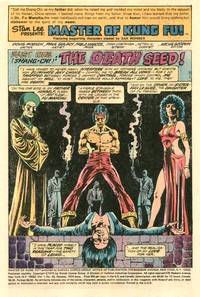 |
|
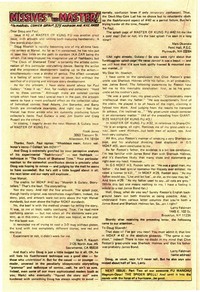 |
|
| |
| Acquiring the rights to Sax Rohmer's characters came
with a short-term sales boost and a long-term problem.
The
sales boost worked instantly. Shang-Chi made his debut in
Special Marvel Edition #15
(December 1973), a former reprint title, and
resonated so well with readers that
Special
Marvel Edition was simply retitled as
of issue #17, becoming Master of Kung Fu (with
the prefixed tagline The Hands of Shang-Chi).
It ran for 109 issues before being cancelled with Master
of Kung Fu #125 in June 1983.
|
| |
| The long term
problem was that while Shang-Chi was a Marvel
character, Fu Manchu was not.
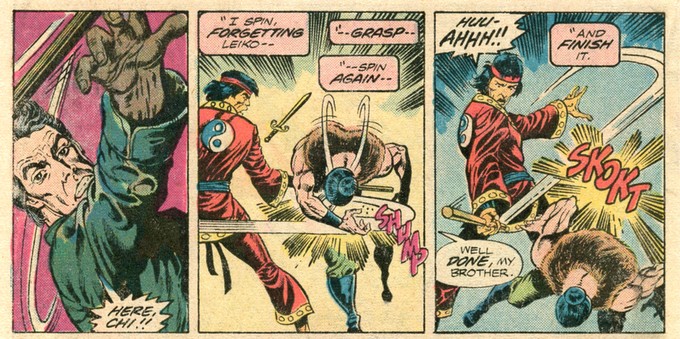
Created by Sax Rohmer for his
1913 novel The Mystery of Dr. Fu Manchu
(released in the US as The Insidious Dr. Fu
Manchu), the character and name had to be
licensed from the Rohmer estate. A major reason
for doing so, it seems, is that Roy Thomas at the
time had been told that DC might look into a Fu
Manchu title if Marvel did anything in the way of
Kung Fu (Cronin, 2019).
However, when Marvel cancelled
the series, they lost the rights to Fu Manchu (as
was the case with many characters Marvel licensed
in the 1970s, e.g. Godzilla). It
created a problem for Marvel's own Shang-Chi
(since so much of his character background
was tied up in the relationship with his evil
father), making further appearances of the
"Master of Kung Fu" somewhat
complicated and leading to various retcon
measures in attempts to not have to use the name
Fu Manchu.
|
|
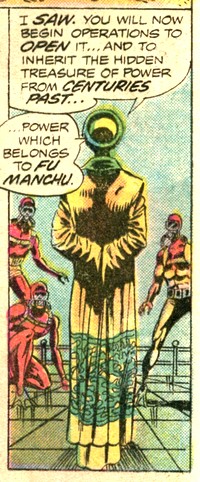
Even
though actually only appearing in one single
panel of this issue of MOKF, Fu Manchu is
mentioned several times and is part of the plot -
a fact that prevented reprints for decades.
|
|
| |
| But what was therefore totally impossible for the
longest time, was for Marvel to reprint any of the
original Master of Kung Fu material - until a
licensing agreement was once again reached with the
Rohmer estate in 2015. As a result, Marvel rushed the
entire Bronze Age MOKF material to the printers and
published it in four volumes of Omnibus format
collections between 2016 and 2017. |
| |
 |
|
This is the first
issue of a six-part storyline
culminating in Master of Kung
Fu #50, with each issue
narrated by a different character
(part 1, in this issue, by
Shang-Chi). However, Master
of Kung Fu was a rare find
in a MARVEL MULTI-MAGS (to
date only three such occasions
are known), so there was no way
one could have followed that arc
with what was available over the
following months in subsequent MARVEL
MULTI-MAGS. |
|
|
|
| |
| |
|
| |
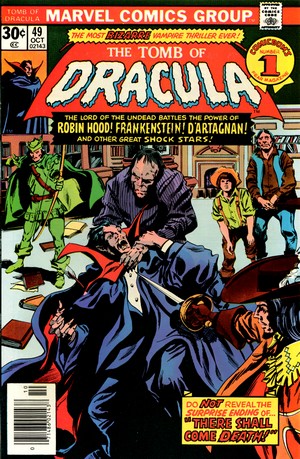
|
|
TOMB OF
DRACULA #49
October
1976
(monthly)
On Sale:
6 July 1976
Editor - Marv
Wolfman
Cover - Gene Colan (pencils)
& Tom Palmer(inks)
"And
with the Word there shall come
Death!"
(18 pages)
Story
- Marv Wolfman
Pencils - Gene Colan
Inks - Tom Palmer
Lettering -
John Costanza
Colouring - Michele Wolfman
STORY
OVERVIEW
- Dracula
is mysteriously summoned to
appear in the presence of a woman
who has become infatuated with
him through Bram Stoker's novel -
and where he meets other
characters from famous works of
fiction.
As per the cover blurb's
request, the surprise ending of
this one-issue-interlude story
shall not be revealed...
|
|
|
|
| |
| Marvel's intentions of
including Dracula in the foray into new genres on which
the House of Ideas was embarking were first announced to
the general readership in the July 1971 Bullpen Bulletin.
The initial plans for Tomb Of Dracula (the
extension to the vampire count's name was necessary for
Marvel to be able to copyright the title) saw the title
as a black and white magazine; the decision to use the
traditional colour comic book format came as late as
after completion of Gene Colan's artwork for the first
issue (Cooke, 2001). |
| |
| In April
1972, Tomb Of Dracula #1 hit the
newsagents stands, and inspite of an initial lack
of constant authorship (Gerry Conway worked on
issues #1-2, Archie Goodwin on issues #3-4, and
Gardner Fox on issues #5-6), this horror title
found favour with its readership, and the title
went from bi-monthly to monthly publication as of
Tomb of Dracula #9 in June 1973. It would soon become Marvel's
flagship horror title. Being far more than just
an average vampire tale, it broke new grounds as
it wove an ongoing saga which plotted the vampire
count against a group of vampire hunters. Gene
Colan and Marv Wolfman (who took over the writing
as of issue #7) achieved a quality of
storytelling which was not only in the best vein
of the classic gothic vampire stories but also
added its very own stamp of originality and
thematic momentum.
Ultimately,
Tomb Of Dracula would
become the longest running Bronze Age Marvel
horror genre title as well as the longest running
comic book title ever with a villain as its
namegiving hero before it was finally cancelled,
after a staggering 70 issues, in August 1979.
The title's quality and
its lasting appeal and success are inextricably
linked to Gene Colan's artwork (embellished by
inker Tom Palmer) and Marv Wolfman's plotting. It
was, quite simply, one of those cases where a
winning team just happened to come together to
perfection.
|
|
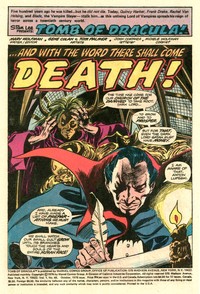 |
|
| |
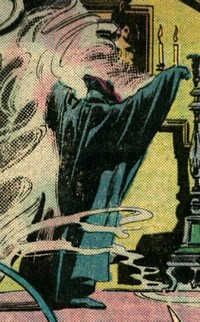
|
|
"Gene's
artwork certainly is the
reason why we could do a lot
of that stuff." (Marv
Wolfman in Siuntres, 2006)
And
while Wolfman followed
Stoker's general lead in his
portrayal of Dracula, he was
decidedly more concerned with the
possibly remaining human traits
in the vampire count's
personality than the novel had
been - not the least, of course,
because Wolfman was not writing a
single publication, but a
serialized narrative.
"[Dracula]
was the protagonist, but he
was never the hero (...) that
was the trick. If you just
saw this guy as a (...)
one-dimensional villain - as
was the standard at the time
[in comic books] - there
would be no way to keep the
series going. This book was
called "Tomb of
Dracula", it wasn't
called "Tomb of Rachel
van Helsing" or
"The Vampire
Hunters" or something
like that, so Dracula had to
become a real character (...)
[there had to be] some
features about him, some
things that still reached
back to when he was
human." (Marv
Wolfman in Comic Geek Speak,
2005)
Together
with the intense and atmospheric
pencilling of Gene Colan and
inking by Tom Palmer, Marv
Wolfman's non-conformist comic
book approach to Bram Stoker's
classic genre character produced a creative
masterpiece.
|
|
|
|
| |
Tomb Of Dracula
owes its uniqueness and much of
its success to an important shift in focus which Marv
Wolfman brought to the title:
"A lot of
us back then were trying to break out of comics just
for kids, and it was very possible for us to do those
things on the non-superhero books, because no one was
paying attention. So Roy Thomas could do that on
Conan, Steve [Englehart] could do that on Doc Strange
and Master of Kung-Fu, [Steve] Gerber could do it on
Man-Thing or Howard the Duck, and I could do it on
Dracula - and those were the books that I think made
the Seventies at Marvel something more than just more
of the same type material that Stan had done - which
we loved, absolutely loved [...] The idea was for
Dracula [...] to try and push comics into other
things, other areas, that they had not
explored." (Marv
Wolfman in Siuntres, 2006)
|
| |
|
| |
 |
|
As pointed out, Tomb
Of Dracula was a rare find
in a MARVEL MULTI-MAGS; to
date only three issues (#23, #49
and #56) are known to have been
included in the selection. The
general absence of horror titles
from MARVEL MULTI-MAGS during
the 1970s is quite striking in
comparison to rival DC's Superpacs
(which featured them a lot).
There was quite obviously a
certain hesticancy with regard to
Marvel's horror titles -
something that only changed in
the early 1980s, when a number of
issues of Ghost Rider
regularly found their way into
MARVEL
MULTI-MAGS. |
|
|
|
| |
| |
|
| |
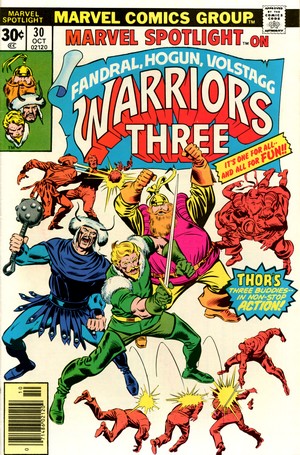
|
|
MARVEL
SPOTLIGHT #30
October
1976
(bi-monthly)
On Sale:
13 July 1976
Editor - Len Wein
Cover - Rich Buckler (pencils)
& Joe Sinnott (inks)
"A
Night on the Town!"
(18 pages)
Story
- Len Wein
Pencils - John Buscema
(breakdowns), Joe Sinnott
(finished artwork)
Inks - Joe Sinnott
Lettering -
Joe Rosen
Colouring - Glynis Oliver
STORY
OVERVIEW
- Left
to their own devices on the
streets of New York by Thor (who
left for
Costa Verde to deal with Firelord*),
the Warriors Three (Fandral the
Dashing, Hogun the Grim and
Volstagg the Enormous) hail a cab
in search of adventure. They end
up rescuing a suicidal young
woman and reuniting her with her
wrongly accused and hence errant
fiancé.
* The story takes place
between Thor #247 and
248.
|
|
|
|
| |
| Marvel Spotlight was one of three "tryout
titles" (the others being Marvel Premiere
and
Marvel Feature) launched at Stan Lee's suggestion
(Howe, 2012) with the intention of giving writers and
artists at Marvel a platform to introduce new concepts
and characters. From a publisher's point of view it was
also a fairly risk-free means of assessing a feature's
popularity without the marketing investment required to
actually launch a new series (which also kept potential
financial losses and any blows to the publisher's image
to a minimum in case a new character tanked with
readers). |
| |
The choice of
titles was somewhat suggestive -
Marvel
Premiere could be expected to premier new
characters while Marvel Spotlight would
most likely spotlight established characters -
but
"I don't think Stan [Lee] (or I)
cared much what went where. They were just
names to us." (Roy Thomas in
Buttery, 2014)
Marvel did try to put some order into things
later, as the letters page of
Marvel
Premiere #32 explained:
"SPOTLIGHT is a try-out book for
previously-introduced Marvel characters (...)
In PREMIERE, however, we want to establish a
slightly different bent, showcasing new ideas
and concepts."
|
|
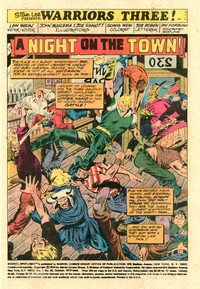 |
|
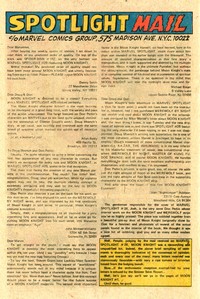 |
|
| |
| Marvel Spotlight was launched in November 1971
and would prove to be a very successful launchpad for new
characters and titles over the course of its 33 issues
before being cancelled in April 1977, as the following
list of features shows. |
| |
| Marvel Spotlight #1 |
November 1971 |
Red Wolf |
moved to own title |
| Marvel Spotlight #2-4 |
February 1972 - June 1972 |
Werewolf By Night |
moved to own title |
| Marvel Spotlight #5-11 |
August 1972 - August 1973 |
Ghost Rider |
moved to own title |
| Marvel Spotlight #12-24 |
October 1973 - October 1975 |
Son of Satan |
moved to own title |
| Marvel Spotlight #25 |
December 1975 |
Sinbad |
|
| Marvel Spotlight #26 |
February 1976 |
Scarecrow |
|
| Marvel Spotlight #27 |
April 1976 |
Sub-Mariner |
|
| Marvel Spotlight #28-29 |
June 1976 - August 1976 |
Moon Knight |
moved to own title |
| Marvel Spotlight #30 |
October 1976 |
Warriors Three |
|
| Marvel Spotlight #31 |
December 1976 |
Nick Fury Agent of S.H.I.E.L.D. |
|
| Marvel Spotlight #32 |
February 1977 |
Spider-Woman |
moved to own title |
| Marvel Spotlight #33 |
April 1977 |
Deathlok and Devil-Slayer |
|
|
| |
| The Warriors Three certainly stand out a bit, given
that they were introduced as far back as August 1965 (in
Journey
into Mystery #119) as Asgardian supporting characters
to Thor. Entirely devoid of any roots in Norse mythology,
the trio is an all-out Marvel creation by Stan Lee and
Jack Kirby and were, in fact, only referred to as the
"Warriors Three" for the first time in the
letters page of Thor #244 (February 1976), which
also promised an appearance in Marvel Spotlight
(Buttery, 2014). |
| |
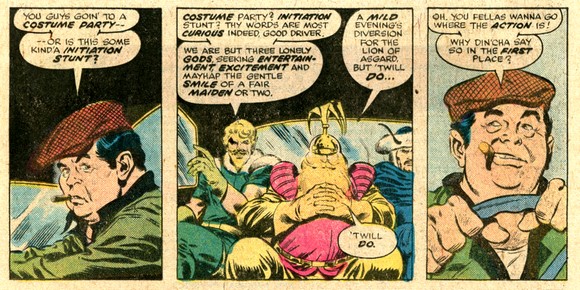
|
|
It seems unlikely
that their single issue Spotlight
adventure was intended to test
the waters for their own title -
"A Night on the Town"
feels more like a one-off fun
story for which Spotlight
provided an ideal slot
opportunity. Len Wein set up
the "we are but three lonely
Gods seeking entertainment"
theme and in doing so had lots of
fun himself.
"It was just such
a joy to write, and the late
great John Buscema's artwork
didn't exactly hurt it
no-how." (Len Wein
in Buttery, 2014)
|
|
|
|
"Much
of the fun comes from the
trio's fish-out-of-water
status, coupled with their
total obliviousness to that
fact." (Buttery, 2014)
The Warriors
Three continued to be supporting
characters for Thor, at times
even taking on important roles.
They have also
featured in various TV animation
series and are also present in
all the Thor movies of the Marvel
Cinematic Universe (although all
three are killed by Hela in Thor:
Ragnarok).
|
|
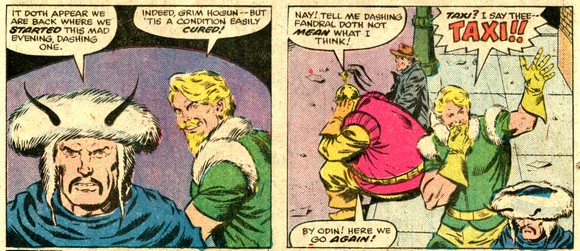 |
|
|
|
| |
| |
|
|
 |
|
To date,
Marvel
Spotlight #30 is the only
known occurence of that title in
a MARVEL
MULTI-MAGS. However, there
is a
concurrent
MARVEL MULTI-MAGS
with a green label which also
features Marvel Spotlight #30
but instead of Master of Kung
Fu #45 and Tomb of
Dracula #49 carries Daredevil
#138 and Ka-Zar #18. |
|
|
|
| |
| |
|
| |
 |
|
Today,
any MARVEL MULTI-MAGS is a time
capsule; opening that plastic bag
offers a nostalgic glimpse into
what it was like to be a comic
book reader in the 1970s. And
then as now, the combination of
the three titles in these sealed
polybags could go either way;
sometimes it's all thrills, and
sometimes there's a lemon in
there - or two, if you're really
unlucky. |
|
|
|
|
|
I
am pretty certain that, back in
the days, I would have considered
this MARVEL MULTI-MAGS
a
treasure chest simply based on
the presence of Master of
Kung Fu and Tomb Of
Dracula.
MOKF
(the acronym used by fans for Master
of Kung Fu) #45 does have a
slightly confusing way of telling
its story, as changes in locale
are not announced as usual with
blurbs such as "Meanwhile,
back in ...". But the story
flows, and since Moench had by
that point in time brought in
espionage in the form of MI6 and
other agents, the pace is fast
and the twists and turns of the
storyline both surprising and
frequent. On top of that, Fu
Manchu is clearly staging a
comeback, and Switzerland always
makes for a good spy story
backdrop. Four out of five stars.
I
would have appreciated Tomb
Of Dracula #49 as much back
in the days as I do today. Since
the title is a true rarity in the
world of
MARVEL
MULTI-MAGS (as is, of
course, MOKF), this is a true
treat. Marv Wolfman would from
time to time weave in
single-issue stories, which often
seemed to serve the purpose of
letting the dust settle a bit
between the end of one plot arc
and the beginning of the next.
The one told here in TOD (another
acronym often used on letterpages
and the likes) #49 really does
fire on all cylinders and gives
Gene Colan a chance to draw a few
characters not readily associated
with Dracula, on top of his
marvelously cinematic pencils he
always brought to the title. Five
out of five stars.
Marvel
Spotlight #30 is the
surprise here for me. I'm not
entirely sure I would have liked
this a lot in my early teenage
days of reading comic books back
in the mid-1970s, but reading it
now for the first time, I found
this to be amazing. Len Wein had
a real knack for writing stories
full of warmth and heart, and his
humour is so spot on I wouldn't
hesitate to call this an
overlooked classic, especially
since John Buscema just makes it
flow effortlessly. Five out of
five stars, hands down.
All
in all, this is one of those MARVEL
MULTI-MAGS that
just brings back all the good
vibes one remembers getting from
reading Marvel comic books back
in the days.
|
|
|
|
|
| |
|
|
| |
| |
 |
|
Today,
any MARVEL MULTI-MAGS is a time
capsule; opening this plastic bag
right here offers a nostalgic
glimpse into what it was like to
be a comic book reader in October
1976. So what else was
going on back then?
|
|
|
|
|
|
 |
|
The US
Billboard Chart saw three
number 1s during October
1976: Walter
Murphy and the Big Apple
Band with "A Fifth
of Beethoven" as
well as Chicago with
"If you leave me
now" for one week
each, while Rick Dees and
His Cast of Idiots got
two weeks at the top with
"Disco Duck (Part
1)". In the
UK, ABBA with
"Dancing Queen"
and Pussycat with "Mississippi"
topped the charts for two
weeks each - clearly not
reflecting at all the
fact that 1976 was the
year that Punk Rock
exploded onto the British
music scene. |
|
|
|
|
|
 |
|
The New
York Times Bestseller
list for October 1976 was
topped by Leon Uris'
"Trinity", a
spot he occupied since
June; by the end of
October, however, the
number one position would
go to Agatha Christie's
posthumously published
last Miss Marple book,
"Sleeping
Murder".. |
|
|
|
|
|
|
 |
|
In
October 1976 John
Schlesinger's
"Marathon Man"
was the most popular
movie in the US. Overall,
"Rocky" was the
US top-grossing movie
while "Jaws"
(which had been released
in 1975 in the States)
topped the 1976 list in
the UK. |
|
|
|
|
|
|
 |
|
In the
US, all of the three most
popular TV shows came
from ABC, with
"Happy Days"
taking the top spot.
Numbers for the UK are
sketchy, but it appears
that the TV premiere of
James Bond's
"Goldfinger"
got the most viewers to
sit down in front of the
telly. |
|
|
|
|
|
|
| |
|
|
| |
| FURTHER
READING ON THE THOUGHT
BALLOON |
| |
| |
 |
|
"Comic
packs" not only sold well
for more than two decades, they
also offer some interesting
insight into the comic book
industry's history from the 1960s
through to the 1990s. There's
more on their general history here. |
|
|
|
| |
 |
|
There's more on
the background and the history of
the Marvel Multi Mags here. |
|
|
|
| |
 |
|
There's more
background information and
discussion of the "yellow
and green on white (3 comics for
89˘)" label MARVEL MULTI-MAGS here. |
|
|
|
| |
 |
|
There's more
in-depth information on the
background of Tomb Of Dracula,
its creators and its publication
history, here. |
|
|
|
| |
| |
|
| |
BIBLIOGRAPHY
| |
| |
| BREVOORT
Tom (2007) "Marvel Multi-Mags", Blah Blah
Blog, originally published online 28 April
2007, reposted 18 April 2020 BUTTERY
Jarrod (2014) "Ready for the
Spotlight", in Back Issue! #71,
April 2014
COOKE Jon
B. (1998) "Stan the Man & Roy the Boy: A
Conversation Between Stan Lee and Roy Thomas", in Comic Book Artist #2,
Summer 1998
COOKE
Jon B. (2001) "Son of Stan: Roy's Years
of Horror", in Comic Book Artist #13,
2001
CRONIN
Brian (2019) "Did Marvel Have a License for Fu
Manchu Before Shang-Chi Was Created?", published online at CBR,
27 May 2019
ENGLEHART
Steve (2016) "Introduction", in The
Hands of Shang-Chi, Master of Kung Fu Omnibus,
Volume 1
HOWE
Sean (2012) Marvel Comics - The Untold Story,
Harper Collins
PEARL Barry
(2012) "Lost in Licensing: Exit Fu Manchu", published online at Comic
Book Collectors Club, 27 June 2012 (at
archive.org)
SIUNTRES
John (2006) "Marv Wolfman by Night", Word
Balloon: The Comic Creator's Interview Show
(transcribed from the podcast originally
available online at wordballoon.libsyn.com)
|
|
| |
| |
|
| |
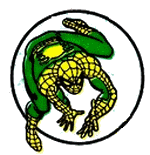
|
| |
|
| |

(c) 2021
uploaded
to the web 14 November 2021
|
| |
|
| |
|


